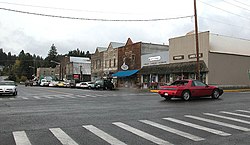Roslyn, Washington
| Roslyn, Washington | |
|---|---|
| City | |

Downtown Roslyn
|
|
 Location of Roslyn, Washington |
|
| Coordinates: 47°13′30″N 121°0′11″W / 47.22500°N 121.00306°WCoordinates: 47°13′30″N 121°0′11″W / 47.22500°N 121.00306°W | |
| Country | United States |
| State | Washington |
| County | Kittitas |
| Area | |
| • Total | 4.37 sq mi (11.32 km2) |
| • Land | 4.37 sq mi (11.32 km2) |
| • Water | 0 sq mi (0 km2) |
| Elevation | 2,247 ft (685 m) |
| Population (2010) | |
| • Total | 893 |
| • Estimate (2015) | 903 |
| • Density | 204.3/sq mi (78.9/km2) |
| Time zone | Pacific (PST) (UTC-8) |
| • Summer (DST) | PDT (UTC-7) |
| ZIP code | 98941 |
| Area code(s) | 509 |
| FIPS code | 53-60055 |
| GNIS feature ID | 1525216 |
| Website | City of Roslyn |
Roslyn is a city in Kittitas County, Washington, United States. The population was 893 at the 2010 census. Roslyn in located in the Cascade Mountains, about 80 miles east of Seattle.
The town was founded in 1886 as a coal mining company town. During the 20th century, the town gradually transitioned away from coal, and today its economy is primarily based on forestry and tourism. The town was the filming location for The Runner Stumbles, Northern Exposure, and The Man in the High Castle. Much of the town's history is preserved, and its downtown is designated a National Historic Landmark.
Coal deposits were first noted in the Roslyn area in 1883, with a large vein discovered at the upper Smith Creek canyon in 1885 by C.P. Brosious, Walter J. Reed, and Ignatius A. Navarre. Roslyn was platted in 1886 by Logan M. Bullet, vice president of the Northern Pacific Coal Company The first commercial coal mining operations were begun to support railway operations.
Throughout the mid-1880s, the Northern Pacific Railway, the parent of Northern Pacific Coal Company, pushed from the east to reach Puget Sound across the Cascade Mountains. The Northern Pacific began building across Stampede Pass just west of Roslyn, approaching from Wallula in the east and Tacoma in the west. A 77-mile (124-km) gap remained in 1886. In January of that year, Nelson Bennett was given a contract to construct a 9,850 foot (3,002 m) tunnel under Stampede Pass, completing it in 1888. Roslyn, which lies on the route to Stampede Pass, provided the coal for the railway construction work as well as the continuing railroad operations.
...
Wikipedia
